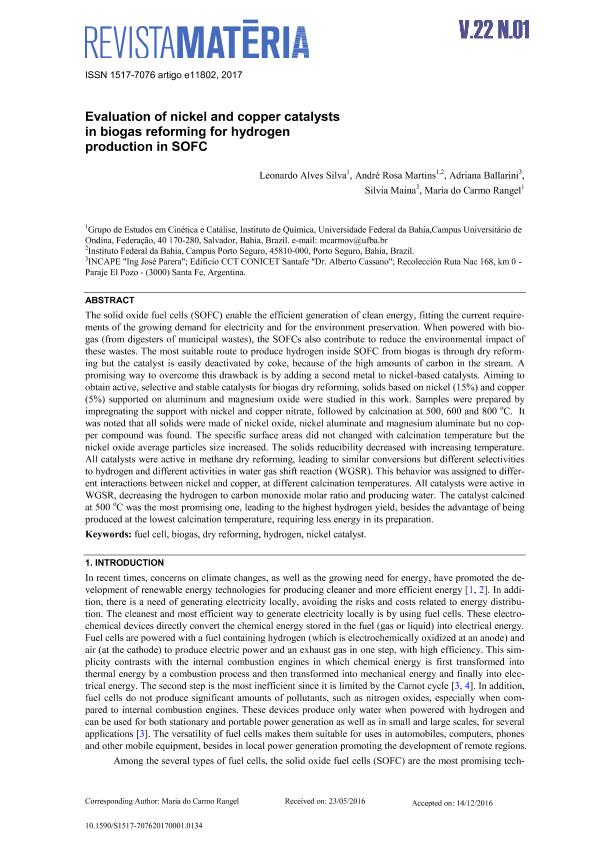Mostrar el registro sencillo del ítem
dc.contributor.author
Alves Silva, Leonardo
dc.contributor.author
Martins, André Rosa
dc.contributor.author
Ballarini, Adriana Daniela

dc.contributor.author
Maina, Silvia Carolina Palmira

dc.contributor.author
Rangel, Maria do Carmo

dc.date.available
2023-01-23T13:47:24Z
dc.date.issued
2017-01
dc.identifier.citation
Alves Silva, Leonardo; Martins, André Rosa; Ballarini, Adriana Daniela; Maina, Silvia Carolina Palmira; Rangel, Maria do Carmo; Evaluation of nickel and copper catalysts in biogas reforming for SOFC; Universidade Federal do Rio de Janeiro; Matéria; 22; 1; 1-2017; 1-11
dc.identifier.issn
1517-7076
dc.identifier.uri
http://hdl.handle.net/11336/185255
dc.description.abstract
The solid oxide fuel cells (SOFC) enable the efficient generation of clean energy, fitting the current require-ments of the growing demand for electricity and for the environment preservation. When powered with bio-gas (from digesters of municipal wastes), the SOFCs also contribute to reduce the environmental impact of these wastes. The most suitable route to produce hydrogen inside SOFC from biogas is through dry reform-ing but the catalyst is easily deactivated by coke, because of the high amounts of carbon in the stream. A promising way to overcome this drawback is by adding a second metal to nickel-based catalysts. Aiming to obtain active, selective and stable catalysts for biogas dry reforming, solids based on nickel (15%) and copper (5%) supported on aluminum and magnesium oxide were studied in this work. Samples were prepared by impregnating the support with nickel and copper nitrate, followed by calcination at 500, 600 and 800°C. It was noted that all solids were made of nickel oxide, nickel aluminate and magnesium aluminate but no cop-per compound was found. The specific surface areas did not changed with calcination temperature but the nickel oxide average particles size increased. The solids reducibility decreased with increasing temperature. All catalysts were active in methane dry reforming, leading to similar conversions but different selectivities to hydrogen and different activities in water gas shift reaction (WGSR). This behavior was assigned to differ-ent interactions between nickel and copper, at different calcination temperatures. All catalysts were active in WGSR, decreasing the hydrogen to carbon monoxide molar ratio and producing water. The catalyst calcined at 500°C was the most promising one, leading to the highest hydrogen yield, besides the advantage of being produced at the lowest calcination temperature, requiring less energy in its preparation.
dc.format
application/pdf
dc.language.iso
eng
dc.publisher
Universidade Federal do Rio de Janeiro

dc.rights
info:eu-repo/semantics/openAccess
dc.rights.uri
https://creativecommons.org/licenses/by-nc/2.5/ar/
dc.subject
BIOGAS
dc.subject
DRY REFORMING
dc.subject
FUEL CELL
dc.subject
HYDROGEN
dc.subject
NICKEL CATALYST
dc.subject.classification
Otras Ingeniería Química

dc.subject.classification
Ingeniería Química

dc.subject.classification
INGENIERÍAS Y TECNOLOGÍAS

dc.title
Evaluation of nickel and copper catalysts in biogas reforming for SOFC
dc.type
info:eu-repo/semantics/article
dc.type
info:ar-repo/semantics/artículo
dc.type
info:eu-repo/semantics/publishedVersion
dc.date.updated
2023-01-23T00:39:56Z
dc.journal.volume
22
dc.journal.number
1
dc.journal.pagination
1-11
dc.journal.pais
Brasil

dc.journal.ciudad
Rio de Janeiro
dc.description.fil
Fil: Alves Silva, Leonardo. Universidade Federal da Bahia; Brasil
dc.description.fil
Fil: Martins, André Rosa. Instituto Federal Da Bahia; Brasil
dc.description.fil
Fil: Ballarini, Adriana Daniela. Consejo Nacional de Investigaciones Científicas y Técnicas. Centro Científico Tecnológico Conicet - Santa Fe. Instituto de Investigaciones en Catálisis y Petroquímica "Ing. José Miguel Parera". Universidad Nacional del Litoral. Instituto de Investigaciones en Catálisis y Petroquímica "Ing. José Miguel Parera"; Argentina
dc.description.fil
Fil: Maina, Silvia Carolina Palmira. Consejo Nacional de Investigaciones Científicas y Técnicas. Centro Científico Tecnológico Conicet - Santa Fe. Instituto de Investigaciones en Catálisis y Petroquímica "Ing. José Miguel Parera". Universidad Nacional del Litoral. Instituto de Investigaciones en Catálisis y Petroquímica "Ing. José Miguel Parera"; Argentina
dc.description.fil
Fil: Rangel, Maria do Carmo. Universidade Federal da Bahia; Brasil
dc.journal.title
Matéria

dc.relation.alternativeid
info:eu-repo/semantics/altIdentifier/url/https://revistas.ufrj.br/index.php/rm/article/view/13713
dc.relation.alternativeid
info:eu-repo/semantics/altIdentifier/url/https://www.scielo.br/j/rmat/a/GDgc7NzLRSP9Y6VprRqkKFN/?lang=en
dc.relation.alternativeid
info:eu-repo/semantics/altIdentifier/doi/https://doi.org/10.1590/S1517-707620170001.0134
Archivos asociados
